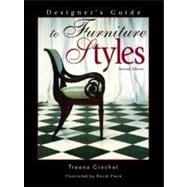
Treena Crochet. After receiving a Masters degree in art and architectural history from the University of North Texas, award-winning author Treena Crochet spent seventeen years in the classroom teaching interior design courses in the United States and the Middle East. As president of A Matter of Style, Ltd., a Boston-based interior design consulting firm, she is an Allied Member of the American Society of Interior Designers. Currently, Ms. Crochet spends most of her time speaking at national and international industry conferences and working on a new book series for the Taunton Press on historic homes. For more information, please visit the company website: www.styleltd.com.
I. HISTORICAL DEVELOPMENTS.
II. THE MODERN WORLD.
III. FURNITURE TECHNOLOGY.
The New copy of this book will include any supplemental materials advertised. Please check the title of the book to determine if it should include any access cards, study guides, lab manuals, CDs, etc.
The Used, Rental and eBook copies of this book are not guaranteed to include any supplemental materials. Typically, only the book itself is included. This is true even if the title states it includes any access cards, study guides, lab manuals, CDs, etc.